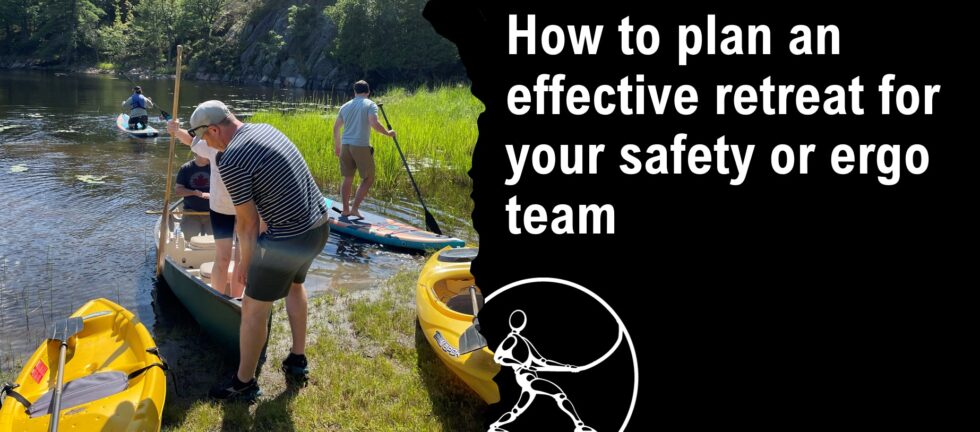Annual “retreat” events can reduce burnout, improve team synergy, and foster innovation, which are crucial aspects for HR and safety leaders looking to enhance organizational well-being. Professional development is a very high priority for our team, since ergonomics is a developing field. We spend one full day every second week together; our regular agenda includes a lot of sharing and problem-solving, some formal professional development, some teambuilding, a review of one new research paper, and collaborative work. We also participate in at least one annual conference, as a team. But even with more than 10% of our time dedicated to career- and team-building, we still book at least one 2-day off-site retreat every year. Why?
- Time away builds a stronger team. Even at conferences, we don’t often get the chance to truly relax together. Sometimes it’s good to take time to get to know each other as people, rather than always through the professional lens. We always include social time, around a campfire or on a trail. We cook together, eat together, and chill together. Years from now, we’ll still be talking about Alex’s legendary pizza, that time the dog jumped out of the canoe, and behind-the-scenes tours at the Stratford Festival.
- Improves connections between team members, and between the team and the company. Most days, when we’re working on projects, we are very client-focused, and that makes a lot of sense. Our retreat allows us to connect with our co-workers, and to connect with Taylor’d Ergo and its goals and values.
- Dedicated time together allows us to work on collaborate on bigger initiatives. We’ve used retreats to create entire courses, to build our ergo design guidelines, to overhaul the format of a specific type of report, and to set goals for the upcoming months or years. We created our “on-site ergo” program during a retreat. Last year we worked on “gamification” of our training, which involved every board game you can imagine (and some you can’t).
- Without the distractions of client projects to complete, we can be more creative and focus exclusively on the retreat’s agenda. We don’t need grueling long days, and we don’t have to drive anywhere at the end of the day.
- Retreats support tangible business outcomes, such as improving safety protocols, increasing employee engagement, and driving team productivity. You can really “get stuff done”, but more than that, you can develop relationships that will carry forward in the workplace.
As I plan for our September cottage getaway, I’ve been thinking about what has made previous retreats successful:
- Clear goals. If we’re dedicating 2 full days, for all of us, I want to ensure that we focus on what is important. Every retreat goal is different, but I’ve learned that identifying specific goals, and allocating the appropriate amount of time for them, is critical to productivity.
- Time for fun. A retreat doesn’t have to be scheduled like a regular work day. If the weather is nice, an afternoon hike or paddle, before returning for a late afternoon brainstorm, can work nicely. Checking out the sunrise or sunset can be invigorating. Allowing some time to do “nothing” is also important.
- A participative menu. We’ve had retreats where everything was catered (and that can be nice) but recently we’ve asked team members to select a meal or two to plan and execute, with help. This alleviates the burden on the host, and also allows us to share our favourite recipes.
- No distractions. We never promise to deliver work to clients during retreats, and we respond only to emergency messages.
- A venue that is comfortable for the participants. In the past, we’ve used various hotels, and even a day spa. Sometimes we use our regular meeting venue, and schedule fun evening events. For the past few years, we’ve retreated to a cottage on Georgian Bay, so leisure activities tend to be nature- or water-focused. At times, our team has included people who were not “outdoorsy” – if you are terrified of critters, a cottage retreat might cause stress, rather than alleviate it. I don’t like “heights”, so I have endured a Christmas party that included rock-climbing, but two days of that would do me in. 😉
And while we are talking about a “comfortable venue”, you’ll want to consider ergonomics:
-
- If employees will be sitting for hours (which is avoidable!), ensure that supportive chairs are provided.
- Get people standing to meet, at least occasionally!
- If they’ll have to use a laptop, provide the peripherals.
- Make sure everyone can see the visuals without craning their necks.
- Incorporate frequent activity micro-breaks. What a great opportunity to use your Move-it program!
I’m really looking forward to spending time with our team this fall! (And we’d love to welcome a new team member – if you know a great ergonomist who is looking for an amazing team to work with, we’re looking to hire in Hamilton, Cambridge, or Mississauga.)
Considering a retreat for your ergo or safety team? We’ve got you! Our “gamified” training cost-justification workshop will energize your team and show them how productivity, quality, and employee engagement can be measurably improved by ergonomic improvements! You can send your team to “retreat” with us in Cambridge, on October 10, or we can come to your chosen venue, anytime. We’ve done the work to create this incredible one-day workshop, which would make an excellent “day 1” agenda for your next retreat. Might I suggest that Day 2 could focus on how to integrate the cost-benefit analysis model into your own work practices?


